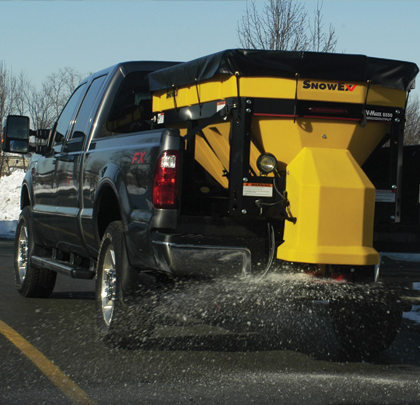The job of snow and ice management professionals is to create safe driving and walking conditions for others. However, in the process it can be easy for them to slip up on their own safety precautions. Take salt and sand spreaders, for instance. So much focus is placed on material types and application rates that people sometimes overlook the proper techniques for installing, operating, and maintaining the equipment safely.
A wide range of outcomes can result from not following the safety recommendations provided by the manufacturer. Oftentimes, no damage is done by handling spreaders incorrectly. But, on the other hand, the consequences can get much worse, such as personal injury, property damage, costly downtime, and equipment repairs. To help prevent any of these setbacks, here are several helpful hints for staying safe while spreading.
INSTALLATION
The first rule of spreader safety is to ensure the equipment is installed securely. Here are a few tips that are consistent among various makes and models of V-box spreaders.
A key step is to bolt the spreader to the truck chassis using the mounting holes provided in the spreader frame. This is necessary to make sure the spreader stays firmly in place. Next, the operator should run ratchet straps from the front corners of the spreader to the rear tie-downs of the truck. Then, he should run ratchet straps from the rear corners of the spreader to the front tie-downs of the truck. These straps provide extra security in case the mounting bolts fail. The final step is installing the stop brackets provided with the spreader. These brackets go in-between the spreader and the truck cab, and they help prevent the spreader from sliding forward and hitting the cab in the event of a quick stop.
LOADING
After a spreader is securely installed in the truck bed, it’s important to pay attention to how the spreader is loaded with deicing material. Level the load from front to back to distribute the weight evenly. Some spreaders offer a cab-forward design to help shift the weight properly, but this feature isn’t available from all manufacturers.
Most snow and ice professionals want to load the spreader as full as possible—oftentimes past the brim—in order to reduce the number of times they need to refill the hopper. Although this may seem like the most efficient way to work, it often surpasses the payload capacity of the truck.
Exceeding the truck’s gross vehicle weight rating (GVWR) causes multiple issues. Not only can it produce unnecessary wear and tear on the vehicle, but it also creates unsafe driving conditions. The tires, suspension, brakes, and other vital truck components aren’t designed for overweight operation, so they may not function properly under a heavy load. This may cause an accident, blown tire, or other expensive breakdown. Additionally, being overweight may result in a costly DOT fine, which can quickly wipe away the profits made from a snow event. After the hopper is filled, be sure to cover the load with a tarp. This feature increases safety by keeping material from flying out of the hopper. Not to mention, it’s the law in many states.
OPERATION
Even if the hopper isn’t overloaded with salt or sand, it still affects how the truck will handle. Take a one-cubic-yard spreader, for instance. At full capacity it can weigh more than 1.5 tons. This amount of weight significantly increases the braking distance of the truck, so the driver must allow extra time to stop. Furthermore, the driver must also make slower turns, since the truck carries more forward momentum when cornering. If an inexperienced operator isn’t made aware of these factors before getting behind the wheel, he may learn these lessons the hard way.
During operation, spreader safety is fairly straightforward. The number one rule is to not turn the spreader on while pedestrians are in the area. Of course, it can be difficult to spot all pedestrians from the truck’s cab, since V-box spreaders block the view out the rear-facing window. Therefore, the operator must learn how to efficiently use the side-view mirrors, and he should also turn on the spreader’s work light to provide extra visibility in dark and stormy conditions.
MAINTENANCE
The next set of safety tips applies to servicing spreaders. In a perfect world, all maintenance would be performed during an off day in the shop, but that isn’t always feasible. Sometimes a spreader needs to be fixed at the worst possible time—during a storm—when snow and ice professionals are rushing to get back on the job. But no matter what day or time maintenance must be performed, it’s important to have patience, use common sense, and not cut corners in order to correct issues.
Fortunately, spreader manufacturers have tried to prevent maintenance-related accidents by incorporating a variety of safety features into their designs. For instance, some spreaders have an auto-reverse feature on the material feed system to automatically clear material jams, so the operator doesn’t have to unclog the unit by hand.
If, however, the material feed system does require servicing, the operator typically has to remove the spinner assembly to correct the issue. But, the electronic controller on some spreaders can detect when the spinner is removed, and it won’t allow the spreader to start back up until the spinner is reinstalled. This helps prevent the operator from coming into contact with moving parts of the spreader, such as the auger.
Simply put, following safe practices is in everybody’s best interest. Not only does it help protect the operator, but it also increases the safety of surrounding drivers and pedestrians, which is what snow and ice professionals are meant to do in the first place. ■
About the Author:
Barry Truan is vice president, marketing and development, with SnowEx. For more information, visit www.snowexproducts.com.
_________________________________________________________________________
Modern Contractor Solutions, January 2014
Did you enjoy this article?
Subscribe to the FREE Digital Edition of Modern Contractor Solutions magazine.

Spreading on the Safe Side


